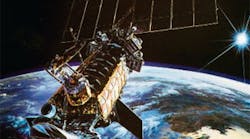Space-based systems such as satellites require extremely reliable components. Microwave manufacturers that supply space-qualified and high-reliability products must meet rigorous screening and testing requirements to ensure that their components can endure the harsh environment.
Satellite-based services are essential not only to military and research personnel, but also to a growing number of commercial consumers. After all, how many remote telephone customers rely on a telephone system that connects by means of spacecraft managed by Iridium? Still, the image that many readers have of satellite services is a system of satellites, along the lines of those developed for the Defense Meteorological Satellite Program (DMSP) by Lockheed Martin's Space Systems Co. These specialized satellites (see figure) provide weather predictions in support of the united states military for planning operations on land, in the air, and at sea. The satellites are equipped with an advanced sensor suite that can image visible and infrared cloud cover as well as measure precipitation, surface temperature, and soil moisture.
Most companies that sell components into space-based applications rely on screening and testing based on some form of military-level environmental and mechanical specifications, such as MILSTD-883B. In fact, the military's "Class S" specifications probably represent the closest thing that exists to a universally acceptable set of environmental standards for space-based applications.
Earlier this year, as part of its electronic parts and packaging program (NEPP), NASA presented its NEPP electronic parts technology Workshop (NEPP ETW 2011), "When is Qualification Not Qualification?" This workshop reviewed how different parts came to be considered space qualified; it made clear that acceptable levels of shock and vibration are critical during launch, deployment, and operation, and that thermal cycling and vacuum conditions are constant concerns. It was also noted that foreign object debris (FOD) is a threat to any space-based application because of the microgravity conditions. But because of the extreme differences between many space-based systems, it is difficult to create a unified set of screening requirements.
For example, the expected danger from solar particles and cosmic rays varies widely from system to system. With systems on earth, the moon, Mars, and in low-earth-orbit (LEO) and geosynchronous-earth-orbit (GEO) satellites, NASA specifies components that must operate within different atmospheres and even gravitational forces. some of NASA's operating environments, such as the moon, have to contend with such issues as surface dust, while all of the environments have a major concern with electrostatic-discharge (ESD) protection. Although NASA does not have a true "space-qualified" list of requirements, the space agency will refer to such qualifications as MIL-PRF-38534/38535 space Level class K/V or aerospace TOR XYZ.
Many microwave companies devote entire product lines to space-qualified applications. Among these are Lorch Microwave, which offers a full brochure on its screening capabilities, and Hittite Microwave Corp. with a brochure detailing its die/wafer screening per MIL-STD-883. MITEQ employs five class 100,000 and two class 10,000 clean rooms in support of high-reliability space and military business.
Manufacturing for space, of course, also involves a major investment in specialized equipment. MITEQ continues to add such equipment as shock and vibration test stations and fine and gross leak testers, as well as RF/microwave test equipment, including noise-figure meters, phase-noise analyzers, synthesized test signal generators, and microwave vector network analyzers (VNAs). Both MITEQ and Narda Microwave have devoted considerable resources to the development of space-qualified integrated microwave assemblies. Narda's model 81000 satellite-communications transceiver integrates a frequency upconverter and downconverter, a 13-W linear Ku-band amplifier, power supply, and control circuits into a package measuring just 15 x 6.25 x 3.25 in. (see Microwaves & RF, November 2010, p. 95).

